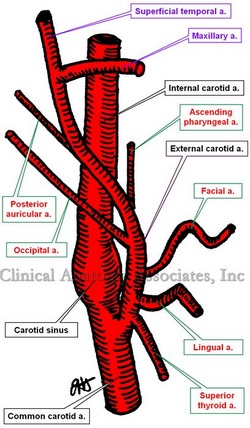The term [carotid] is Greek and means "to sleep", "to stupefy", or "to put to sleep". This arises from the observed fact that compression of the large arteries in the neck caused animals to fall asleep (Rufus of Ephesus c.100BC). Andrea Vesalius proposed the name "soporalis arteriae", but the Greek term [carotid] is what we use today.
The carotid arterial system is bilateral. On the right side, the right common carotid artery arises from the brachiocephalic trunk, while on the left side the left common carotid artery arises from the aortic arch. The common carotid artery divides into an external and an internal carotid artery. The internal carotid artery presents a dilation close to its origin, the carotid sinus, and then heads superiorly to enter the carotid canal of the temporal bone. The internal carotid artery does not give any branches in the neck region and ends providing important branches to the eye and the arterial circle of Willis, which supplies part of the brain.
The external carotid ends giving origin to two arteries, the superficial temporal artery and the maxillary artery. The external carotid artery gives off six named branches:
• Superior thyroid artery
• Lingual artery
• Facial artery
• Ascending pharyngeal artery
• Occipital artery
• Posterior auricular artery
Sources:
1. "The ancient Hellenic and Hippocratic origins of head and brain terminology" Panourias IG, et al Clin Anat 2012 Jul;25(5):548-581
2. "The origin of Medical Terms" Skinner, AH, 1970
Images property of: CAA.Inc. Artist: Dr. E. Miranda




